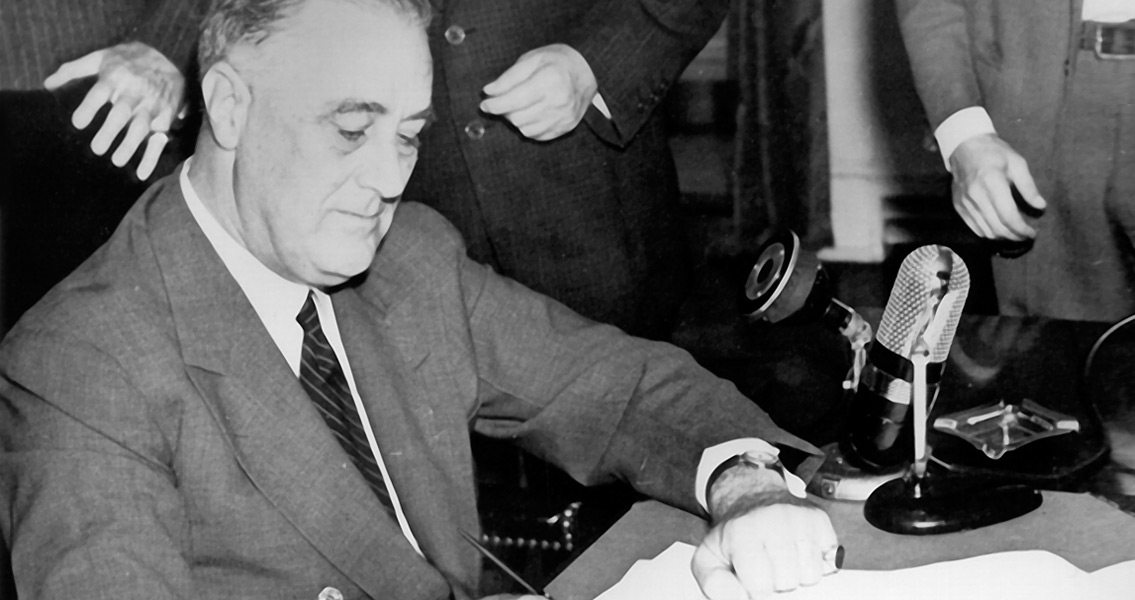<![CDATA[On the 20th January 1945 Franklin Delano Roosevelt was inaugurated for a record fourth term as president of the United States. Roosevelt held office through two of the most difficult events in US history; the Great Depression and the Second World War. Seventy years after his final inauguration, Roosevelt's presidency and legacy continue to be analysed and reevaluated. Roosevelt was born in 1882 in Hyde Park Village, New York. He was the only child of his wealthy parents, James and Sara Delano Roosevelt. His fifth cousin, Theodore, was elected as US President in 1900, and proved to be an inspiration for Roosevelt in his youth. Roosevelt was educated by private tutors in his childhood, before attending the prestigious law school at Columbia University. At the age of 28 he entered politics for the first time, representing the Democrat party. He won the Senate Seat for Dutchess County, despite its Republican majority. In 1913 President Woodrow Wilson named Roosevelt Assistant Secretary of the Navy, a position which became increasingly important when the US entered the First World War in 1917. In the 1920 election Roosevelt was the Democrat candidate for vice-President, but a year later a disaster struck which could have brought an end to Roosevelt's political career. Contracting poliomyelitis (polio), Roosevelt largely disappeared from the public eye for several years. Roosevelt worked to regain the use of his legs, and in 1924, with the aid of crutches, made an appearance at the Democrat convention. In 1928 Roosevelt became governor of New York, although he would continue to have to use crutches or a wheelchair for the rest of his life. Roosevelt was elected the 32nd President of the United States in 1932, during the worst of the Great Depression. By the time of his first inauguration, there were 13,000,000 unemployed in America, and almost every bank had closed. The Wall Street Crash had devastated the stock market, causing families to lose their life savings and businesses to close down. Faith in the banking system had all but disappeared, meaning people started to keep their savings at home instead of investing them in banks. This, combined with a new caution towards spending, meant there were few signs of economic recovery. The "first hundred days" of Roosevelt's presidency saw a host of sweeping changes for the American economy, aimed at restoring consumer confidence and faith in the banking system. Known as the New Deal, these changes represented a movement away from Laissez-faire politics to a much more hands on, Keynesian approach. Rather than attempting to balance budgets, the New Deal saw the US government invest heavily in public works, welfare and refinancing of mortgages. Roosevelt said in his inaugural speech that American's had "nothing to fear but fear itself". The state investment of the New Deal was an attempt to alleviate that fear. As the Second World War erupted during Roosevelt's third term, he became involved in some of the most controversial actions of his presidency. Since the end of the First World War America had been increasingly isolationist, distancing itself from events in Europe. Historians debate the exact motivations behind Roosevelt's actions, but it is clear that he was reluctant to see France and Great Britain defeated and Europe dominated by Germany. Even before the Japanese attack on Pearl Harbour pulled the USA into direct military involvement, the USA had provided aid to the British war effort following the fall of France, in the form of financial support and the sale of weapons. Roosevelt's critics, at the time and since, have argued that he had embroiled the USA in a war it did not need to get involved in, and conspiracy theorists have even suggested he conspired with Winston Churchill to allow the Japanese attack on Pearl Harbour -to justify American military intervention. Decades after his death, the image of Franklin D. Roosevelt is constantly being reshaped. While many still celebrate the New Deal as a major success, one which brought Social Security and economic recovery to the US, others treat it as a backwards, unsustainable step which put the US government into substantial debt. Other controversies of Roosevelt's presidency have come to light, or are now being discussed in much greater detail, such as the treatment of Japanese immigrants in the United States during the war, or the concessions made to Stalin at the Yalta Conference towards the end of the war. On the anniversary of the inauguration of Roosevelt's final term, the 32nd President is perhaps more controversial than ever before, as details of his life have been analysed in substantial detail by subsequent generations. For those critical of Roosevelt it is easy to overlook his achievements, and the popularity that led to his record breaking run as president. For supporters, it is easy to turn a blind eye to controversies, or attempt to justify them through their context. Both processes lead to misconceptions and exaggerations of a politician who played a defining role in the twentieth century, in the US and abroad. ]]>
Roosevelt's Final Inauguration
